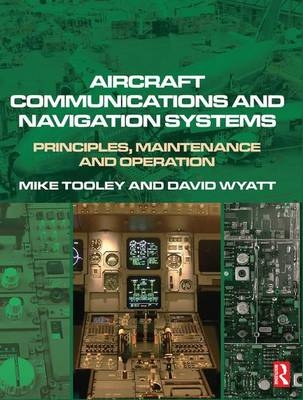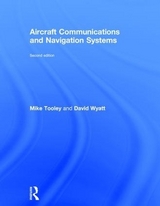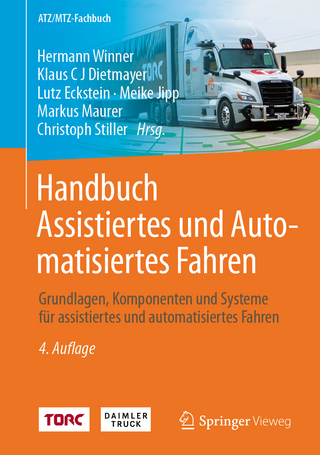
Aircraft Communications and Navigation Systems
Routledge (Verlag)
978-1-138-17082-7 (ISBN)
- Titel erscheint in neuer Auflage
- Artikel merken
This book provides an introduction to the principles of communications and navigation systems. It is written for anyone pursuing a career in aircraft maintenance engineering or a related aerospace engineering discipline, and in particular will be suitable for those studying for licensed aircraft maintenance engineer status. The book systematically addresses the relevant sections (ATA chapters 23/34) of modules 11 and 13 of part-66 of the EASA syllabus. It is ideal for anyone studying as part of an EASA and FAR-147 approved course in aerospace engineering.
Mike Tooley has over 30 years of teaching electronic principles, electronics and avionics to engineers and technicians, previously as Head of Department of Engineering and Vice Principal at Brooklands College in Surrey, UK, and currently works as a consultant and freelance technical author. David Wyatt has over 45 years’ experience in the aviation industry, including Head of Airworthiness at Gama Aviation, and an FE lecturer in avionics engineering. David is co-author in the aircraft engineering book series and has written BTEC National specifications.
Chapter 1 Introduction
1.1 The radio frequency spectrum
1.2 Electromagnetic waves
1.3 Frequency and wavelength
1.4 The atmosphere
1.5 Radio wave propagation
1.6 The ionosphere
1.7 MUF and LUF
1.8 Silent zone and skip distance
1.9 Multiple choice questions
Chapter 2 Antennas
2.1 The isotropic radiator
2.2 The half-wave dipole
2.3 Impedance and radiation resistance
2.4 Radiated power and efficiency
2.5 Antenna gain
2.6 The Yagi beam antenna
2.7 Directional characteristics
2.8 Other practical antennas
2.9 Feeders
2.10 Connectors
2.11 Standing wave ratio
2.12 Waveguide
2.13 Multiple choice questions
Chapter 3 Transmitters and receivers
3.1 A simple radio system
3.2 Modulation and demodulation
3.3 AM transmitters
3.4 FM transmitters
3.5 Tuned radio frequency receivers
3.6 Superhet receivers
3.7 Selectivity
3.8 Image channel rejection
3.9 Automatic gain control
3.10 Double superhet receivers
3.11 Digital frequency synthesis
3.12 A design example
3.13 Multiple choice questions
Chapter 4 VHF communications
4.1 VHF range and propagation
4.2 DSB modulation
4.3 Channel spacing
4.4 Depth of modulation
4.5 Compression
4.6 Squelch
4.7 Data modes
4.8 ACARS
4.9 VHF radio equipment
4.10 Multiple choice questions
Chapter 5 HF communications
5.1 HF range and propagation
5.2 SSB modulation
5.3 SELCAL
5.4 HF data link
5.5 HF radio equipment
5.6 HF antennas and coupling units
5.7 Multiple choice questions
Chapter 6 Flight-deck audio systems
6.1 Flight interphone system
6.2 Cockpit voice recorder
6.3 Multiple choice questions
Chapter 7 Emergency locator transmitters
7.1 Types of ELT
7.2 Maintenance and testing of ELT
7.3 ELT mounting requirements
7.4 Typical ELT
7.5 Cospas–Sarsat satellites
7.6 Multiple choice questions
Chapter 8 Aircraft navigation
8.1 The earth and navigation
8.2 Dead reckoning
8.3 Position fixing
8.4 Maps and charts
8.5 Navigation terminology
8.6 Navigation systems development
8.7 Navigation systems summary
8.8 Multiple choice questions
Chapter 9 Automatic direction finder
9.1 Introducing ADF
9.2 ADF principles
9.3 ADF equipment
9.4 Operational aspects of ADF
9.5 Multiple choice questions
Chapter 10 VHF omnidirectional range
10.1 VOR principles
10.2 Airborne equipment
10.3 Operational aspects of VOR
10.4 Multiple choice questions
Chapter 11 Distance measuring equipment
11.1 Radar principles
11.2 DME overview
11.3 DME operation
11.4 Equipment overview
11.5 En route navigation using radio navigation aids
11.6 Multiple choice questions
Chapter 12 Instrument landing system
12.1 ILS overview
12.2 ILS ground equipment
12.3 ILS airborne equipment
12.4 Low range radio altimeter
12.5 ILS approach
12.6 Autoland
12.7 Operational aspects of the ILS
12.8 Multiple choice questions
Chapter 13 Microwave landing system
13.1 MLS overview
13.2 MLS principles
13.3 Aircraft equipment
13.4 Ground equipment
13.5 MLS summary
13.6 Multiple choice questions
Chapter 14 Hyperbolic radio navigation
14.1 Hyperbolic position fixing
14.2 Loran overview
14.3 Loran-C operation
14.4 Loran-C ground equipment
14.5 Loran-C airborne equipment
14.6 Enhanced Loran (eLoran)
14.7 Multiple choice questions
Chapter 15 Doppler navigation
15.1 The Doppler effect
15.2 Doppler navigation principles
15.3 Airborne equipment overview
15.4 Typical Doppler installations
15.5 Doppler summary
15.6 Other Doppler applications
15.7 Multiple choice questions
Chapter 16 Area navigation
16.1 RNAV overview
16.2 RNAV equipment
16.3 Kalman filters
16.4 Required navigation performance
16.5 Multiple choice questions
Chapter 17 Inertial navigation systems
17.1 Inertial navigation principles
17.2 System overview
17.3 System description
17.4 Alignment process
17.5 Inertial navigation accuracy
17.6 Inertial navigation summary
17.7 System integration
17.8 Multiple choice questions
Chapter 18 Global navigation satellite system
18.1 GPS overview
18.2 Principles of wave propagation
18.3 Satellite navigation principles
18.4 GPS segments
18.5 GPS signals
18.6 GPS operation
18.7 Other GNSS
18.8 The future of GNSS
18.9 Multiple choice questions
Chapter 19 Flight management systems
19.1 FMS overview
19.2 Flight management computer system
19.3 System initialisation
19.4 FMCS operation
19.5 FMS summary
19.6 Multiple choice questions
Chapter 20 Weather radar
20.1 System overview
20.2 Airborne equipment
20.3 Precipitation and turbulence
20.4 System enhancements
20.5 Lightning detection
20.6 Multiple choice questions
Chapter 21 Air traffic control system
21.1 ATC overview
21.2 ATC transponder modes
21.3 Airborne equipment
21.4 System operation
21.5 Automatic dependent surveillance-broadcast
21.6 Communications, navigation and surveillance/air traffic management
21.7 Multiple choice questions
Chapter 22 Traffic alert and collision avoidance system
22.1 Airborne collision avoidance systems
22.2 TCAS overview
22.3 TCAS equipment
22.4 System operation
22.5 Multiple choice questions
Appendices
1 Abbreviations and acronyms
2 Revision papers
3 Answers
4 Decibels
Index
| Erscheinungsdatum | 13.08.2016 |
|---|---|
| Verlagsort | London |
| Sprache | englisch |
| Maße | 189 x 246 mm |
| Gewicht | 794 g |
| Themenwelt | Technik ► Fahrzeugbau / Schiffbau |
| Technik ► Luft- / Raumfahrttechnik | |
| ISBN-10 | 1-138-17082-8 / 1138170828 |
| ISBN-13 | 978-1-138-17082-7 / 9781138170827 |
| Zustand | Neuware |
| Informationen gemäß Produktsicherheitsverordnung (GPSR) | |
| Haben Sie eine Frage zum Produkt? |
aus dem Bereich



